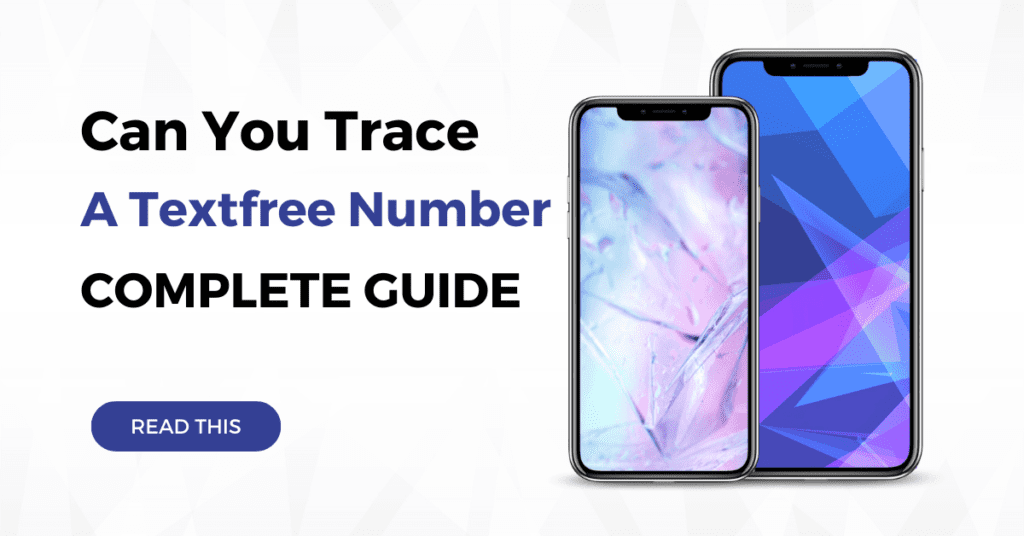In today’s digital era, with so many communication ways, figuring out if can you trace Textfree numbers? When you sees a number on your screen, there’s no familiar caller ID to tell you who’s reaching out. It’s like standing on the edge of curiosity. You start wondering—can you find out who’s behind this mystery number? Let’s talk about whether it’s possible to trace a Textfree number.
The intrigue comes from the mystery, from the idea that every time we interact digitally, there’s a complex exchange of information, like leaving tiny clues for someone curious enough. We’ve all experienced it—your phone beeps and you see a message from a number you don’t recognize. You are uncovering who’s sending it and where they’re from rushes in like excitement. Whether it’s a missed connection, a potential job offer, or an old friend trying to get in touch, the desire to unveil the truth becomes strong.
Can You Trace a Textfree Number?
- Tracing a phone number, including a Textfree number or any other type, typically involves legal and technical processes subject to privacy laws and regulations. Here are a few things to consider:
- Legal Process: To trace a phone number, law enforcement agencies must follow proper legal channels, such as obtaining a court-issued subpoena or warrant, depending on the jurisdiction and the reason for tracing the number. These legal processes are in place to protect individuals’ privacy and ensure that tracing is conducted for legitimate purposes.
- Service Provider Cooperation: Suppose law enforcement has the necessary legal authorization. In that case, they can approach the service provider and request information about the number. Service providers may have logs or records that could help identify the individual using the number.
- Limitations: Tracing a number might only sometimes yield the desired results. People can use apps like textfree to create temporary or disposable phone numbers, making it more challenging to track them down. Additionally, tracing international numbers could involve cooperation with authorities in multiple countries.
- Personal Use: Respecting privacy laws and ethical considerations is essential if you’re trying to trace a number for personal reasons. Tracing someone’s number without proper authorization could lead to legal issues.
How has new technology affected the modern workplace?
What Are Textfree Numbers and Their Usage
Text-free numbers are virtual phone numbers typically provided by mobile apps or online services. These numbers are used primarily for sending and receiving text messages and phone calls, often without a traditional cellular plan or contract. These numbers are commonly used for various purposes, including:
1# Privacy
People often use to maintain their privacy. For example, when signing up for online services or making online purchases, individuals might use a Textfree number to avoid sharing their phone number.
2# Temporary Communication
It can be used for temporary communication needs, such as when you’re selling items online and want to provide a contact number without revealing your primary phone number.
3# Business and Professional Use
Small businesses and professionals might use these numbers as an additional point of contact, allowing them to separate personal and professional communication.
4# Travel
Some people use to communicate with friends and family back home without incurring international roaming charges when traveling abroad.
5# Secondary Phone Number
Some individuals use textfree numbers as secondary phone numbers for specific purposes, like signing up for services or interacting with a different group of people.
6# Online Verification
Many websites and apps require phone number verification to create an account. Textfree numbers can be used for this purpose, especially if you’re concerned about your primary phone number being exposed to potential spam or unwanted communication.
How to Trace a Fake Text Message Number?
Tracing a fake text message number can prove to be a challenging endeavor, often necessitating the involvement of law enforcement or specialized services. If you suspect a text message to be fraudulent or from an unknown source, it’s advisable to refrain from responding.
You take screenshots or photos of the message, including the phone number, timestamp, and content. This documentation could be valuable evidence should you report the incident. Contacting your mobile service provider might yield general information about the number’s origin or enable you to block it.
However, if the situation escalates into a scam or harassment, reporting it to local law enforcement is recommended. They can provide guidance and investigate the matter further. While online reverse lookup tools are available, exercise caution as their reliability can vary significantly.
Are Textfree Numbers as Guardians of Privacy?

It can keep your personal phone number private when you want to communicate without revealing it. They’re good for temporary uses, like signing up for online services, but some websites might not accept them for verification.
Remember that while textfree numbers offer privacy, they’re connected to an online service, so your info could be at risk if there’s a security issue. Also, scammers could misuse them. Just remember, they’re less reliable than regular phone numbers. If your account is deactivated, you might lose access to the number. So, they’re helpful for privacy sometimes, but it’s essential to be cautious.
Conclusion
The process of tracing a Textfree number involves legal and technical procedures governed by privacy laws. Law enforcement necessitates proper authorization, typically in the form of a court-issued warrant, to initiate tracing, prioritizing privacy safeguards and valid grounds for the investigation. Accessing information from service providers is also possible with authorization, potentially unveiling the user’s identity.
These numbers fulfill diverse roles in the digital sphere. These virtual numbers ensure privacy for tasks such as online service registration, cater to temporary communication needs, offer an extra contact point for businesses, aid communication during travel, and act as secondary numbers for specific purposes. Although Textfree numbers offer privacy advantages, users should exercise care and acknowledge their limitations, including the risk of losing the number.





